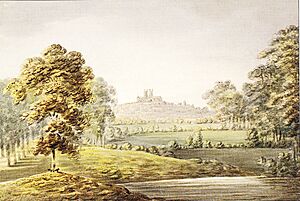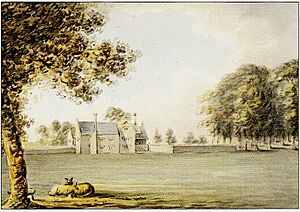Cowick, Devon facts for kids
Cowick is a part of the city of Exeter in Devon, England. Long ago, it was a special type of estate called a manor. It was located in the parish of St Thomas, Exeter. Cowick was also once home to a Benedictine monastery, which was a place where monks lived and worshipped.

Contents
Cowick's Early History
The area of Cowick is mentioned in a very old book called the Domesday Book from 1086. This book listed all the lands in England after William the Conqueror took over. Cowick was owned by a powerful person named Baldwin FitzGilbert, who was also known as Baldwin the Sheriff. He was the Sheriff of Devon for the King.
Monastery at Cowick
After Baldwin the Sheriff died, his son, William FitzBaldwin, gave the lands of Cowick and Exwick to a monastery in France called the Abbey of Bec-Hellouin. Because of this gift, a small monastery, or "cell," was set up in Cowick. It had a church named after Saint Andrew.
This new Cowick Priory received many gifts, including money, rents, and the right to choose priests for churches in nearby areas like Exwick and Spreyton.
A Special Roof in Spreyton
In the church of St Michael in Spreyton, you can still see a long Latin message carved into the wooden roof of the chancel (the part of the church near the altar). This message tells us that Henry le Mayne, a vicar (a type of priest) who was chosen by the monks of Cowick, built the roof in 1451. He got help from Richard Talbot, who was the lord of Spreyton, and from Robert de Rouen, who was the last leader (Prior) of Cowick Priory. The message asks people to pray for their souls.
Important Burials at the Priory
Some important people were buried at the Priory Church in Cowick. These included Hugh de Courtenay, 9th Earl of Devon, who died in 1340, and his wife Agnes. His father, Sir Hugh de Courtenay, and his wife Eleanor were also buried there.
Changes for Cowick Priory
During the time of King Henry V (1413–1422), England was fighting France. Because Cowick Priory was controlled by a French monastery, it was closed down in 1414. The monks had to go back to Normandy in France.
Later, in 1440, King Henry VI reopened the priory. He then gave it to his new school, Eton College, in 1451/2. However, when Edward IV became king in 1461, he took Cowick Priory from Eton and gave it to Tavistock Abbey instead.
For a while, there was some back and forth about who owned the priory. Eventually, in 1478, Tavistock Abbey was confirmed as the owner.
The End of the Monasteries
During the time of King Henry VIII, many monasteries in England were closed down in what was called the Dissolution of the Monasteries. In 1537/8, Tavistock Abbey was given to the King. This meant that its lands, including Cowick and Exwick, were then given to a powerful nobleman named John Russell, 1st Earl of Bedford.
Cowick Barton: From Priory to Pub
Today, a part of the old priory building still stands and is known as Cowick Barton. It is now a public house (a pub). Lord Russell rebuilt the priory building in the 1540s. It might have been used as a home for the person who managed his huge estates in Devon.
The building is made from red stone and is shaped like the letter "E," which was a common design during the Elizabethan period. It still has many of its old stone windows. Inside, there used to be a stained-glass window showing King Edward VI, which is now in a museum. Some old plaster decorations also remain, showing scenes like a nun with children. A fireplace from 1657 with family symbols can also be seen.
Later Owners of Cowick
Over the years, Cowick Barton was owned by several families.
- In 1641, the Earl of Bedford sold the property to the Pate family. Robert Pate, who died in 1677, left it to his son. He also made sure that some money was paid each year to help the poor.
- Later, through marriage, the property went to Amy Fraunceis, and then to her daughter Katherine Prideaux. Katherine had no children and left Cowick to Mr. James White.
- James White continued to give money to charity. He also paid for a schoolmistress to teach four poor children in the parish of St Thomas how to read. The property also had to pay a small amount of money to forty needy people in the parish every year.
- The painter John White Abbott (1763–1851) was born at Cowick. He was the grandson of James White and helped to restore the building.
Cowick Today
In 1920, a large part of the Cowick estate was sold. By 1963, the old house was falling apart. A brewery bought the whole property and turned it into the pub it is today.
Nowadays, Cowick is a big suburb in the west of Exeter. In 2011, about 5,650 people lived there. Cowick doesn't have a main shopping street, but the main roads are Dunsford Road and Cowick Street. There are also some shops and businesses on Bowhay Lane and Buddle Lane.
Cowick is next to other parts of Exeter like St Thomas and Exwick. It is also close to the villages of Pocombe Bridge and Ide, Devon. Because of its location near the A30 road, many people traveling from Okehampton pass through Cowick on their way to Exeter city centre. The closest train station is Exeter St Thomas.
Images for kids



